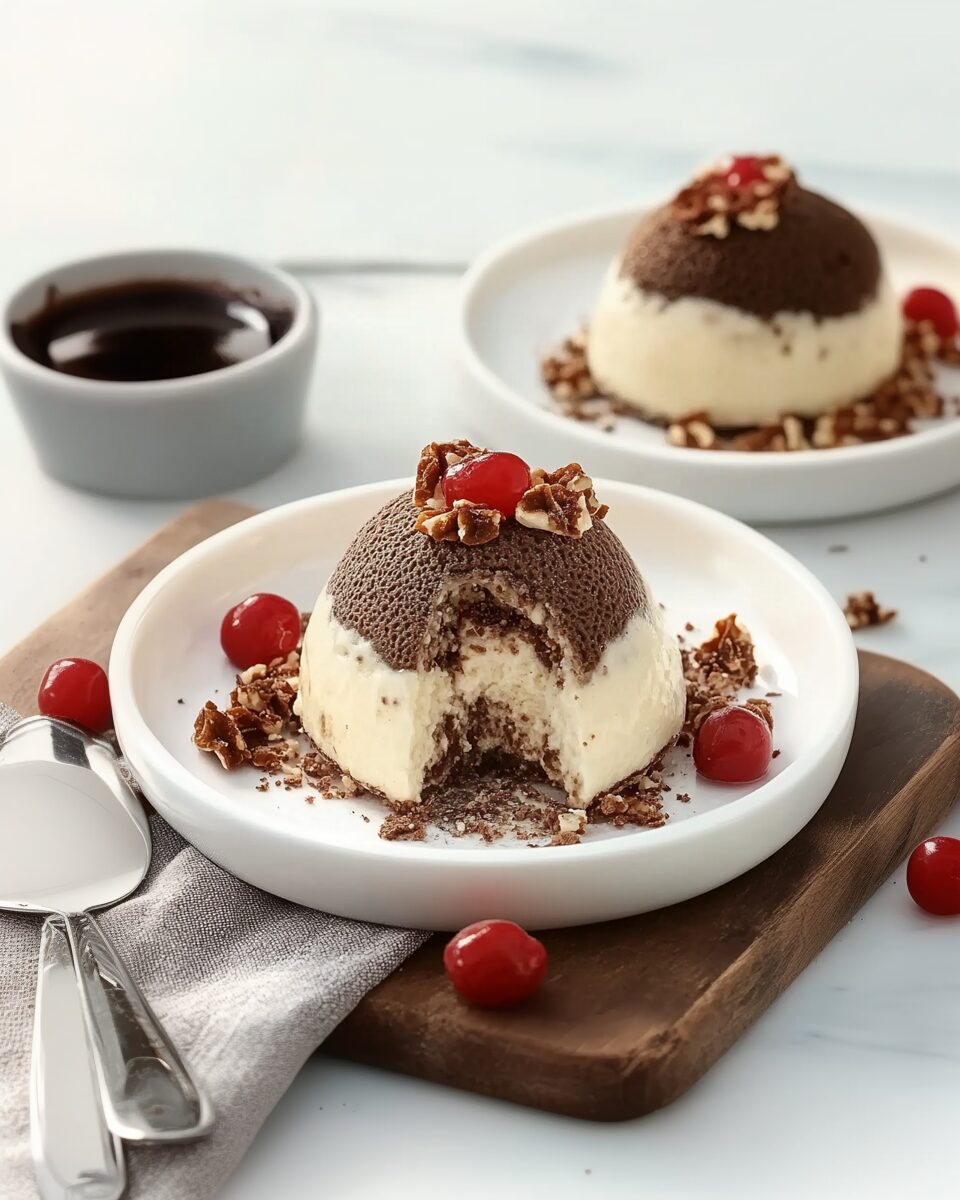Tartufo is a delightful Italian dessert consisting of vanilla ice cream surrounding an amaretto-soaked cherry, all encased in a crunchy chocolate coating. It’s a simple yet elegant treat, perfect for summer gatherings or as a special indulgence.
Full Recipe:
Ingredients
-
5-6 chocolate waffle cones
-
8 scoops vanilla ice cream
-
8 amaretto-soaked cherries
-
12 ounces prepared caramel sauce
-
1/3 cup (40g) chopped walnuts
Directions
-
Place the chocolate waffle cones in a zip-top bag and crush them into fine crumbs using a rolling pin or food processor. Pour the crumbs into a bowl.
-
Using a round ice cream scoop, create a ball of vanilla ice cream.
-
While the ice cream is still in the scoop, use the end of a knife to create a hole in the center.
-
Insert an amaretto-soaked cherry into the hole, pushing it to the center, and smooth the ice cream over the hole.
-
Release the ice cream ball into the bowl of chocolate crumbs.
-
Use a spoon to cover the ball completely with the crumbs, then place it onto a parchment-lined baking sheet.
-
Repeat the process with the remaining ingredients until you have 8 tartufi.
-
Freeze the tartufi for at least 4 hours, or until very firm.
-
Before serving, warm the caramel sauce and pour a small amount onto each of 8 plates.
-
Place a tartufo on each plate, drizzle with additional caramel sauce if desired, and sprinkle with chopped walnuts. Serve immediately.
Nutritional Facts (per serving)
-
Calories: Approximately 350 kcal
-
Protein: 4g
-
Carbohydrates: 45g
-
Fat: 18g
-
Fiber: 2g
-
Sugar: 35g
The Origin of Tartufo
Tartufo is a celebrated Italian dessert that masterfully combines simplicity with elegance. Originating from Italy, this delightful treat features a core of vanilla ice cream encasing an amaretto-soaked cherry, all enveloped in a crunchy chocolate crumb coating. Served atop warm caramel sauce and garnished with chopped walnuts, tartufo offers a harmonious blend of flavors and textures that captivate the palate.
The term “tartufo” translates to “truffle” in Italian, aptly describing the dessert’s resemblance to the prized fungi. Its origins trace back to the town of Pizzo in Calabria, Italy, where it was first crafted in the 1950s. According to legend, a local ice cream maker named Don Pippo faced a shortage of molds while preparing desserts for a princely feast. In a moment of ingenuity, he shaped gelato by hand, placing a cherry in the center and coating it with chocolate and crushed hazelnuts, thus giving birth to the tartufo. This improvisation led to the creation of a dessert that would become synonymous with Pizzo, earning the town the moniker “city of ice cream.” Today, Pizzo’s tartufo holds a Protected Geographical Indication (PGI) status in Italy, signifying its cultural and historical significance.
Composition and Variations
At its core, tartufo consists of two or more flavors of gelato sculpted together, often with a surprise center of melted chocolate or fruit syrup. Traditional flavors include chocolate and hazelnut, but variations abound, incorporating fruits like raspberry, strawberry, or cherry. The dessert is typically enrobed in a shell of chocolate or cocoa powder, though some versions feature coatings of cinnamon or crushed nuts, adding to its textural appeal.
Classic tartufo remains a favorite among traditionalists, but modern interpretations have brought forth an array of exciting flavors and combinations. Some variations replace gelato with sorbetto for a dairy-free option, while others introduce unconventional elements like coffee, matcha, or tropical fruits. The contrast between the outer shell and the creamy, flavorful interior remains a defining characteristic, regardless of the variation.
Preparation Techniques
Crafting tartufo involves a delicate balance of flavors and textures. The process begins with selecting high-quality gelato, known for its dense, rich texture and intense flavor. Unlike traditional ice cream, gelato is made with more milk than cream and is churned at a slower speed, resulting in less air incorporation and a more concentrated taste. Common gelato flavors used in tartufo include chocolate, hazelnut (nocciola), vanilla, and stracciatella.
The surprise center often features a liqueur-soaked fruit, such as a maraschino or Amarena cherry. Soaking the cherry in liqueurs like maraschino, amaretto, or rum imparts an extra layer of complexity to the dessert. To assemble, a scoop of gelato is molded around the soaked cherry, forming a ball. This is then rolled in crushed chocolate waffle cones or wafer cookies, providing a delightful crunch that contrasts with the creamy interior. Freezing the assembled tartufo ensures it holds its shape until serving.
Serving Suggestions
Tartufo is traditionally served on a bed of warm caramel sauce, which complements the cold, creamy gelato with its rich, buttery notes. A sprinkle of chopped walnuts adds a nutty flavor and additional texture, enhancing the overall sensory experience. This dessert is not only a treat for the taste buds but also a visually appealing finale to any meal, making it an excellent choice for dinner parties and special occasions.
For an elevated presentation, tartufo can be drizzled with dark chocolate ganache or dusted with cocoa powder. Fresh berries, mint leaves, or edible flowers can serve as garnishes, adding both aesthetic appeal and a refreshing contrast to the indulgent flavors. Some contemporary chefs even incorporate a flaming presentation by briefly torching the exterior, creating a dramatic effect while enhancing the dessert’s outer layer.
Cultural Significance
The invention of tartufo in Pizzo has had a lasting impact on the town’s identity and economy. The dessert’s popularity has attracted visitors from around the world, eager to sample the authentic “Tartufo di Pizzo.” Local gelaterias have become landmarks, preserving the traditional methods and recipes passed down through generations. The annual tartufo festival in Pizzo celebrates this rich heritage, drawing food enthusiasts and tourists alike. The dessert’s PGI status further underscores its importance, ensuring that only tartufo made in Pizzo according to traditional methods can bear the name “Tartufo di Pizzo.”
Outside Italy, tartufo has become a popular dessert in upscale restaurants and Italian eateries worldwide. It is frequently featured in fine-dining establishments, where chefs experiment with unique flavor infusions and artistic plating techniques. The global appreciation for this dessert highlights its versatility and timeless appeal.
Modern Interpretations
While the classic tartufo remains beloved, contemporary chefs and home cooks have embraced the dessert’s versatility, experimenting with various flavors and presentations. Some modern interpretations include using different gelato combinations, incorporating exotic fruits, or adding layers of cake or biscuit for added texture. Despite these innovations, the essence of tartufo—a harmonious blend of creamy gelato, a surprise center, and a textured coating—remains unchanged, testament to its timeless appeal.
A rising trend in the culinary world involves deconstructed tartufo, where the elements are served separately on a plate, allowing diners to mix and match textures and flavors. Additionally, some chefs have introduced miniature versions of tartufo, making it a convenient option for tasting menus and dessert samplers. Vegan and gluten-free adaptations have also emerged, catering to a broader audience while maintaining the indulgent experience that tartufo provides.
Healthier Alternatives
For those seeking a healthier twist on tartufo, modifications can be made without compromising its signature indulgence. Using natural sweeteners such as honey or agave syrup instead of refined sugar can make the dessert more nutritious. Low-fat or dairy-free gelato options, including almond, coconut, or soy-based varieties, provide alternatives for those with dietary restrictions. Instead of a chocolate coating, a dusting of unsweetened cocoa powder or finely ground nuts can offer a lighter finish.
Incorporating antioxidant-rich ingredients like dark chocolate, nuts, and berries can enhance the dessert’s nutritional profile. Additionally, portion control plays a role in maintaining a balanced diet while still enjoying the exquisite flavors of tartufo. By adopting mindful ingredient choices and preparation methods, tartufo can be transformed into a more health-conscious treat.
Conclusion
Tartufo stands as a shining example of Italian culinary artistry, embodying the creativity and passion that define the country’s gastronomic traditions. From its serendipitous creation in Pizzo to its status as a globally recognized delicacy, tartufo continues to enchant dessert lovers with its delightful combination of flavors and textures. Whether enjoyed in its classic form or through modern variations, tartufo remains a testament to the enduring allure of Italian desserts.






